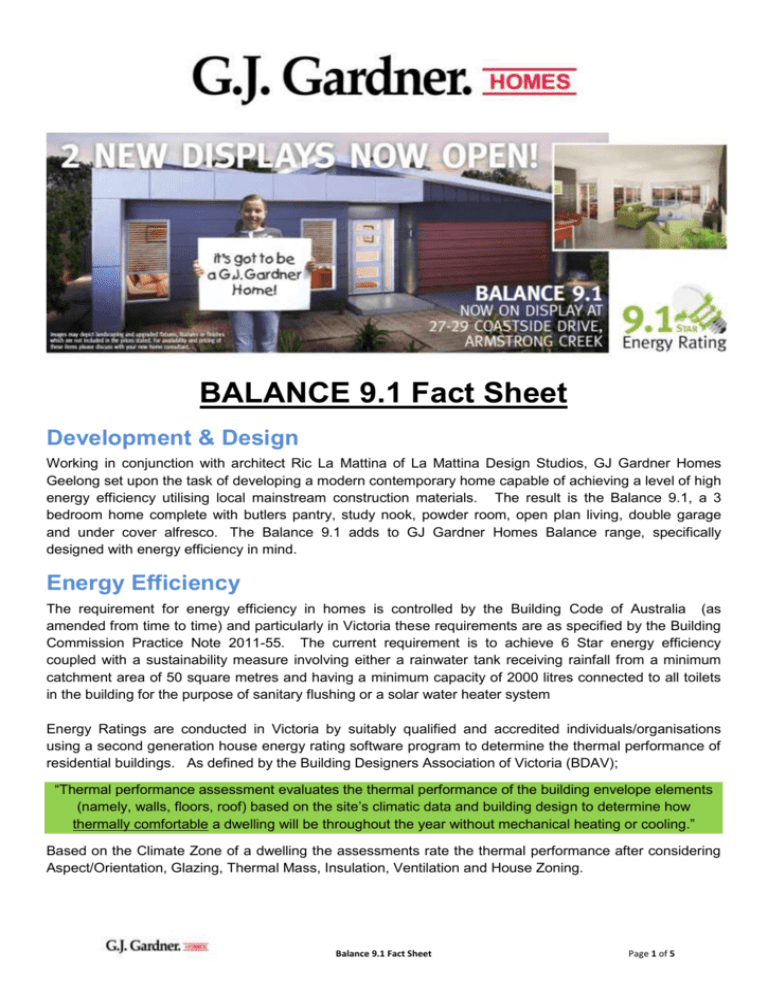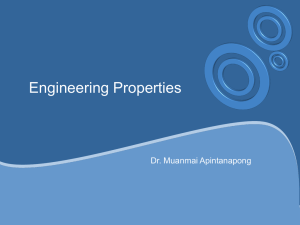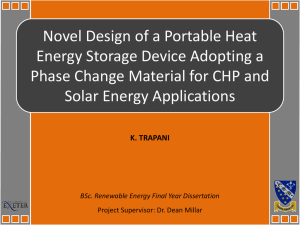BALANCE 9.1 Fact Sheet - Sustainable House Day
advertisement

BALANCE 9.1 Fact Sheet Development & Design Working in conjunction with architect Ric La Mattina of La Mattina Design Studios, GJ Gardner Homes Geelong set upon the task of developing a modern contemporary home capable of achieving a level of high energy efficiency utilising local mainstream construction materials. The result is the Balance 9.1, a 3 bedroom home complete with butlers pantry, study nook, powder room, open plan living, double garage and under cover alfresco. The Balance 9.1 adds to GJ Gardner Homes Balance range, specifically designed with energy efficiency in mind. Energy Efficiency The requirement for energy efficiency in homes is controlled by the Building Code of Australia (as amended from time to time) and particularly in Victoria these requirements are as specified by the Building Commission Practice Note 2011-55. The current requirement is to achieve 6 Star energy efficiency coupled with a sustainability measure involving either a rainwater tank receiving rainfall from a minimum catchment area of 50 square metres and having a minimum capacity of 2000 litres connected to all toilets in the building for the purpose of sanitary flushing or a solar water heater system Energy Ratings are conducted in Victoria by suitably qualified and accredited individuals/organisations using a second generation house energy rating software program to determine the thermal performance of residential buildings. As defined by the Building Designers Association of Victoria (BDAV); “Thermal performance assessment evaluates the thermal performance of the building envelope elements (namely, walls, floors, roof) based on the site’s climatic data and building design to determine how thermally comfortable a dwelling will be throughout the year without mechanical heating or cooling.” Based on the Climate Zone of a dwelling the assessments rate the thermal performance after considering Aspect/Orientation, Glazing, Thermal Mass, Insulation, Ventilation and House Zoning. Balance 9.1 Fact Sheet Page 1 of 5 BALANCE 9.1 (Alfresco Room excluded) THERMAL PERFORMANCE DESIGN RESPONSES Climate Zone Located at the Warralily Coast Display Village in Armstrong Creek, a new suburb on the outskirts of Geelong Victoria, the Balance 9.1 is situated within Climate Zone 6 - Mild Temperate. With four distinct seasons of which Spring and Autumn are ideal for human comfort, the design concerns were around maintaining comfort and reduced energy consumption during Winter and Summer. Orientation The allotment upon which the house is constructed has a North – South orientation. With the north being to the rear of the home it was important to place living zones in this position to take advantage of the sun for heating during Winter while minimising and protecting glazing to the west to assist with cooling in the Summer. The Northern orientation of living zones also assists in capturing natural light and thus reducing the need for excessive artificial lighting. Glazing The priority of glazing is to provide internal warmth to the home by maximising the use of 'free' solar energy in winter while reducing the impact of excessive heat transfer into the building during summer. Heat can be transferred by radiant heat transfer, conducted heat transfer and heat transfer by infiltration of outside air. To achieve the best results it was important to capitalise on radiant heat transfer while reducing conducted heat transfer and infiltration of outside air. Radiant heat transfer is best obtained by windows that insulate well (low U-value) and admit plenty of free solar energy (high solar heat gain coefficient - SHGC). Reducing conducted heat transfer which occurs when the glass and frames heat up or cool down and transfer heat from inside or outside the home is best dealt with the use of still air cavities between surfaces and the use of non-conductive materials in the window construction. While infiltration of outside air can be prevented by the use of appropriate seals in both the window construction and surrounds to close up any potential gaps in the dwelling. Installed in the Balance 9.1 are A&L Windows Double Glazed Timber Awning Windows with U-value of 1.9 & SHGC of 0.50 and Double Glazed Timber Sliding Doors with a U-value of 1.9 and SHCG of 0.54 respectively. The two panes of glass within the double glazing units are separated by a 10mm space filled with Argon which is an inert gas that provides lower conductivity than air. While the timber frames provide no conductivity. In addition, all gaps between the window/door frames and the timber wall frames were sealed with low pressure expansion foam. Thermal Mass Thermal mass is the ability of a material to absorb heat energy. Large amounts of heat energy are required to change the temperature of high density materials like concrete, brick and other masonry. Thus, these products are used to absorb, store and re-release thermal energy which in turn moderates temperatures by averaging day/night extremes and thereby increase comfort and reducing energy costs. However, thermal mass is not an alternative to insulation and in fact should be used with insulation to maximise the benefits. It can delay heat flow by up to 12 hours which in turn means that high mass buildings can regulate internal temperatures over longer periods of time at less expense than lightweight buildings. The use of reverse masonry construction in the Balance 9.1 combined with a centrally placed internal masonry wall and exposed concrete slab provide the thermal mass elements. Balance 9.1 Fact Sheet Page 2 of 5 Reverse masonry construction using James Hardie cement sheet cladding products combined with breathable reflective sisalation paper, 90mm timber framing, R2.7 insulation batts, an air cavity and 90mm concrete blocks was utilised on the external walls of the main living zones (including bedrooms) to produce a system which absorbs and releases internal heat energy will insulating from the external climatic changes. The centrally positioned internal masonry wall was constructed from a system of 10mm plasterboard, 90mm timber framing, R2.5 insulation batts, an air cavity and 90mm concrete blocks to further absorb internal heat energy and re-radiate it through the open plan living zone. A 480mm high (50mm stone base on 300mm of polystyrene pods with 130mm of concrete) waffle pod slab provided the foundations and floor for the Balance 9.1. While the pods provided an insulation factor (refer below) the exposed salt and pepper polished concrete slab provides thermal mass for the storage of heat while also becoming an internal finishing feature of the home. In addition, an in floor gas fired hydronic heating system provides additional warmth to the slab when heat gains from the sun are limited and the thermal mass properties of the concrete enable heat to be radiated throughout the home. Insulation Insulation is essential in the thermal performance of all buildings as it minimizes heat loss and heat gain through the walls, roof and floors. The roofing system consisted of Colorbond steel roof sheets installed over R1.3 insulated blanket and reflective sisalation paper, pre-fabricated roof trusses, with R6.0 Pink Batts installed in the ceiling cavity. External walls were constructed as mentioned above utilising R2.7 Pink Batts, while all internal plasterboard walls were insulated with R2.5 Pink Batts. The floor or concrete slab is of waffle pod construction which provides thermal insulation of the concrete slab from the ground due to the nature of its construction whereby polystyrene pods are used to form voids under the slab. These pods come in various heights of which a 300mm pod was selected for the Balance 9.1 to provide a greater insulation benefit for the 130mm thermal mass concrete layer with which they were covered. Ventilation Primarily concerned with heating the home due to the Climate Zone, natural ventilation to deal with a warmer climate was not a focus and the normal use of awning windows and sliding doors fitted with insect screens was considered appropriate within the design to quickly disperse any excessive build up of warm air within the building. However, to assist in air circulation and comfort within the building, ceiling fans were installed to the living and bedrooms. Of priority however, was the restricting of draughts in order to reduce the number of air volume exchanges which occur due to air leakage and thus impact greatly on the homes heat loss. All external doors were fitted with weather seals to prevent draughts occurring from the gaps between the frames and doors. Ceiling exhaust fans fitted to the bathroom and ensuite are self closing so as to be sealed when not in use and thus prevent heat loss through openings to the ceiling. The same heat loss issue through the ceiling was combatted with the use of sealed downlight fittings being installed. In addition, further sealing of the home occurred to prevent air leakage from the unseen gaps which occur between the window frames and wall frames and the concrete slab and wall frame bottom plate. Low pressure expanding foam was used around the windows as previously mentioned, while the gap between the external wall bottom plate and slab was caulked to provide a seal. Balance 9.1 Fact Sheet Page 3 of 5 House Zoning Creating ‘zones’ by grouping rooms with similar uses together – such as living rooms, bedrooms and wet areas – can allow for more efficient heating and cooling. Limiting the floor size of these areas and the ceiling heights reduces the volume of air within which needs to be thermally controlled. Thus, the consideration of overall house size and ceiling heights becomes a critical factor in the amount of energy a home requires to use for heating and cooling. The Balance 9.1 was designed with this in mind and thus it is a compact yet spacious 3 bedroom home (18.2 squares of living) with 2550mm ceilings throughout except for the raked feature ceiling to the entry. In addition, zoning the home with the inclusion of internal doors between the open plan living and bedroom/wet area hallway and entry allows for the reduction of conditioned air loss when external access from or to the home is required. By closing the internal door to the effected zone before exiting/entering the house or garage can severely reduce the amount heat transferred from one zone to the next and thus reduce the amount of energy required to be used to re-condition the air internally within the home. Sustainability Measure Warralily Coast, Armstrong Creek is a dual pipe Estate, thus providing Class A recycled water to each dwelling. Subsequently, this recycled water is used for sanitary flushing within the home and thereby complies with the Victorian 6 Star Energy Efficiency requirements as a Deemed to Satisfy provision under the BCA. IMPORTANT: The above outlines the design responses and construction methodologies applied to the Balance 9.1 home design as displayed at Lot 12, # 27 Coastside Drive, Warralily Coast, Armstrong Creek, excluding the Alfresco Room which has no energy rating requirements placed upon it. Any adoption of the Balance 9.1 home design and/or its energy efficiency methodologies to an allotment of land other than where it is displayed will not ensure an Energy Rating of 9.1 Stars. Each house plan and the energy efficient design responses and construction methods adopted must be rated individually, based on the physical locality and actual orientation of the home by an accredited Thermal Performance Assessor. Thus, GJ Gardner Homes accepts no liability nor provides any guarantees in respect of energy rating results relative to the Balance 9.1 or any other home plan which adopts the above methodologies on any allotment of land . Balance 9.1 Fact Sheet Page 4 of 5 BALANCE 9.1 - HOME SUSTAINABILITY In looking to further add benefit to the achievement of a High Energy Efficient Home design, GJ Gardner Homes extended it’s commitment to the Balance 9.1 Display Home by looking at Home Sustainability. The focus was to improve sustainability through saving costs associated with energy and water bills while improving the level of comfort within the home. Water Wise Measures Dual pipe estate – Class A recycled water provided from the Black Rock Sewerage Treatment plant to the Warralily Coast estate, supplies sanitary flushing within the home and alfresco while also providing for garden irrigation Rain water tanks – 2 x 2,000lt Slimline tanks capture all rainwater from the dwelling and alfresco roof to provide water for the plunge pool in the entertaining area WEL’s Rated Plumbing Fixtures – GWA Caroma Dorf water efficient shower heads, tap ware and WC’s installed throughout Landscaping – Water wise native and coastal plantings with artificial grass to reduce irrigation requirements Energy Consumption Measures In-Floor Heating – Auspex Gas Fired Hydronic In-Floor heating system installed which uses the concrete floor thermal mass to radiate warmth through the home and thus reduce the need to mechanically condition large volumes of air. Efficient gas heating of the water used. LED Downlights – Fully sealed Sunny Lighting LED Downlights installed throughout. Induction Cooktop – Smeg SIHP294S Induction Cooktop is approximately 30% quicker to heat than conventional cooktops and more efficient with on-demand heat control. Instant Hot Water - Dux Instantaneous Gas Hot Water system provides hot water on-demand which in turn means no energy cost to continuously heat stored water, only heat what you use. PV Solar Panels – TCK Solar supplied and installed 5.4kW SOLbond Solar Panel System provides power to the home but also provides power for the “energy hungry” pool pumps which are programmed to run during the day when the solar system produces the most output. Inverter Pool Pumps – Gordon Avenue Pools & Spas supplied and installed ‘8’ star energy efficient inverter pool pumps which diminish the energy demand through the use of variable pump speeds, unlike the “energy hungry” fixed speed pumps of the past. Inverter Split System Cooling – A Mitsubishi invertor high wall mount split system has been provided for the added comfort in the heat of summer. Although the energy performance of the house should mean a minimal usage requirement, the invertor technology means it will be running as efficiently as possible when required. Window Furnishings – Internal and or external window furnishings greatly assist window performance by regulating heat radiation and loss through shading the external in summer and reducing heat conductivity internally in both winter and summer. Home Automation – Automation Systems & Controls (ASC) have supplied and installed a home automation system designed to interface with lighting, appliances, heating & cooling systems, alarms, etc.. so that at the touch of a screen (in home or via iPhone) you can enable or disable the item giving you ultimate control of your homes electrical energy consumption. Balance 9.1 Fact Sheet Page 5 of 5





